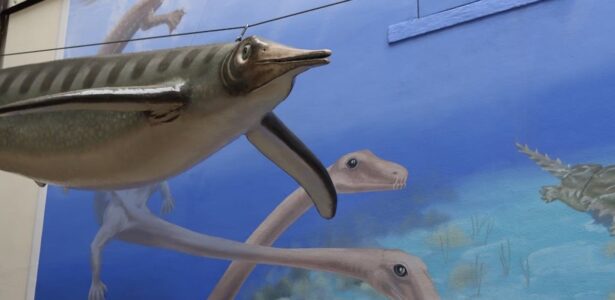Il mare triassico di Besano era abitato da un gran numero di pesci. Uno dei più comuni è Saurichthys, uno snello predatore dalle mascelle sottili armate di denti aguzzi, il cui aspetto ricordava vagamente quello di un luccio. Il corpo era affusolato e, tranne per una fila lungo la linea laterale, privo delle pesanti scaglie tipiche di gran parte dei pesci arcaici. La pinna dorsale e la pinna anale erano molto arretrate come avviene in numerosi pesci attuali che cacciano le loro prede grazie a improvvisi scatti del corpo. Saurichthys poteva superare 80 cm di lunghezza, ma non era il più grande pesce predatore del mare di Besano. Il primato spetta a Birgeria, lungo oltre l m e dotato di un robusto cranio armato di denti conici e aguzzi. Sia Saurichthys sia Birgeria ebbero un grande successo evolutivo tanto che i loro fossili si rinvengono in numerosi giacimenti triassici in tutto il mondo.
BIG PREDATORY FISH
The Triassic sea in the Besano area was inhabited by a large number of fish. One of the most common is Saurichthys, a slim predator with thin jaws and sharp teeth, vaguely reminiscent of a pike. Its body tapered off and – apart from a row along the lateral line-lacked the heavy scales typical of most ancient fish. The dorsal and anal fins were set far back, similar to many kinds of current fish that hunt prey by making sudden darts. Saurichthys could exceed 2.7 ft in length, but it was not the biggest predator fish in the Besano Sea – this particular record is held by Birgeria, more than 3.3 ft long, and equipped with a robust skull with sharp, conical teeth. Both Saurichthys and Birgeria enjoyed great evolutionary success and their fossils can be found in a number of Triassic sites all over the world.





